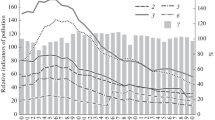Abstract—
The article examines the regional dynamics of atmospheric emissions of 12 post-Soviet countries depending on changes in gross domestic product (GDP) or gross regional product (GRP), volumes and structure of industrial output, and changes in the structure of the fuel balance and energy intensity. During the 1990s crisis, pollution declined in all countries and most regions, but more slowly than production due to the dirtiest industries being more resilient to the crisis. The most persistent was pollution in regions and countries with high volumes of emissions. During the period of economic growth, pollution increased, primarily in hydrocarbon production regions. Regional differences in emissions are mainly due to industrial output for Russia and Ukraine, with a high consistency of production and pollution trends. In Russia, gross emissions are geographically linked to GRP; in Ukraine, a decline in production in the eastern regions has led to a shift in pollution to areas with concentrated populations. In Kazakhstan, the territorial structure of emissions is determined by the volumes of electricity produced by coal generation and the location of energy-intensive industries. In the post-Soviet space, inherited development factors determine pollution from the energy sector, where the most obsolete funds and structure of the fuel balance have been preserved. At the same time large industrial regions in countries have a general tendency to stabilize the level of emissions, while small regions either reduce their emissions, or, conversely, increase them.





Similar content being viewed by others
Notes
National Statistical Committee of the Republic of Kazakhstan. http://stat.gov.kz/faces. Accessed November 19, 2019; Key Environmental Indicators: Statistical Bulletin. http://www.gks.ru. Accessed November 19, 2019.
State report on the state of the environment of the Russian Federation in 2016. Moscow: Ministry of Natural Resources and the Environment of the Russian Federation, 2017. 761 p.
Report on the ecological situation in the Khanty-Mansi Autonomous Okrug − Yugra in 2016, http://www.prirodnadzor.admhmao.ru. Accessed November 19, 2019.
REFERENCES
Artyukhov, V.V. and Martynov, A.S., Metodika otsenki ekologicheskoi i energeticheskoi effektivnosti ekonomiki Rossii (Assessment of the Environmental and Energy Efficiency of the Russian Economy), Moscow: Interfaks, 2010.
Bityukova, V.R. and Popov, A.A., Environmental consequences of structural changes in Russian industry in 1990–2014, Ekol. Prom. Ross., 2015, vol. 19, no. 6, pp. 4–10.
Bobylev, S.N., Zubarevich, N.V., and Solov’eva, S.V., Crisis challenges: how to measure sustainable development, Vopr. Ekon., 2015a, no. 1, pp. 147–160.
Bobylev, S.N., Kudryavtseva, O.V., and Yakovleva, Ye.Yu., Regional priorities of green economy, Econ. Reg., 2015b, no. 2 (42), pp. 148–159.
Farrell, M., The measurement of productive efficiency, J. R. Stat. Soc., 1957, vol. 120, pp. 253–281.
Gómez-Calvet, R., Conesa, D., Gómez-Calvet, A., and Tortosa-Ausina, E., Energy efficiency in the European Union: What can be learned from the joint application of directional distance functions and slacks-based measures? Appl. Energy, 2014, vol. 132, pp. 137–154.
Grossman, G.M. and Krueger, A.B., Environmental impact of a North American Free Trade Agreement: NBER Working Paper No. 3914, Cambridge, MA: Natl. Bur. Econ. Res., 1991, pp. 177–189
Hung, M.F. and Shaw, D., Economic growth and the environmental Kuznets curve in Taiwan: a simultaneity model analysis, in Long-Run Growth and Economic Development: From Theory to Empirics, Boldrin, M. Ed., UK: Edward Elgar, 2006.
Klyuev, N.N., Ecological security of Russia and external treats, Priroda (Moscow), 2002, no. 11, pp. 3–10.
Lopatnikov, D.L., Ecological transition, Reg. Issled., 2013, no. 3 (41), pp. 4–8.
Lopez, R., The environment as a factor of production: the effects of economic growth and trade liberalization, J. Environ. Econ. Manage., 1994, vol. 27, pp. 163−184.
Nagvi, A. and Zwickl, K., Fifty shades of green: revisiting decoupling by economic sector and air pollutants, Ecol. Econ., 2017, vol. 133, pp. 111–126.
Panayotou, T., Empirical Tests and Policy Analysis of Environmental Degradation at Different Stages of Economic Development: ILO Working Papers No. 992927783402676, Geneva: Int. Labor Off., 1993.
Shi, G.-M., Bi, J., and Wang, J.-N., Chinese regional industrial energy efficiency evaluation based on a DEA model of fixing non-energy inputs, Energy Policy, 2010, vol. 38, pp. 6172–6179.
Solodovnikov, A.Yu. and Chistobaev, A.I., Vliyanie neftegazodobychi na sotsial’no-ekologicheskuyu sredu Obskogo Severa (Impact of Oil and Gas Production on the Social and Ecological Environment of the Ob region’s North), St. Petersburg: VVM, 2011.
Stern, D.I., The Environmental Kuznets Curve: A Primer, Canberra: Centre Clim. Energy Policy, Crawford Sch. Publ. Policy, Austr. Natl. Univ., 2014.
Takeda, F. and Matsuura, K., Trade and environment in East Asia: examining the linkages with Japan and the USA, 2006.
Wang, Z.H., Regional total factor energy efficiency: an empirical analysis of industrial sector in China, Appl. Energy, 2012, vol. 97, pp. 115–123.
Funding
The article was prepared within the state budget research topic “Socioeconomic Factors of Transformation of the Territorial Organization of Society in Russia and Neighboring Countries” of the priority research area of Moscow State University “Changes in the Natural Environment and Society and the Problems of Resource Management.”
Author information
Authors and Affiliations
Corresponding authors
Ethics declarations
The authors declare no conflict of interest.
Rights and permissions
About this article
Cite this article
Bityukova, V.R., Shimunova, A.A. Regional Analysis of Differentiation of Industrial Atmospheric Pollution in the Post-Soviet Space. Reg. Res. Russ. 11, 367–377 (2021). https://doi.org/10.1134/S2079970521030023
Received:
Revised:
Accepted:
Published:
Issue Date:
DOI: https://doi.org/10.1134/S2079970521030023




